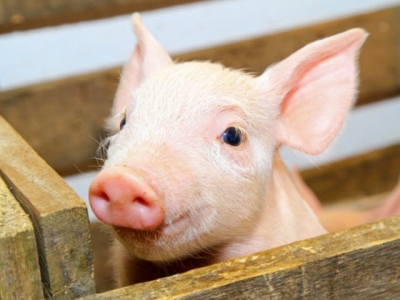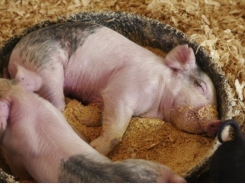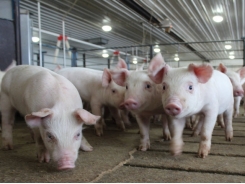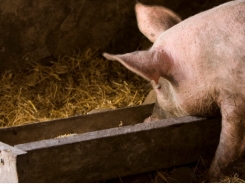More studies needed to back up use of antibiotic alternatives in pig diets: review

Several feed additives may be effective in regulating intestinal environments and improving pig growth performance if diets without antibiotic growth promoters are fed, but results in terms of their various attributes are variable and further research is required, finds a review.
The most commonly used feed additives in pig diets are acidifiers, zinc and copper, prebiotics, probiotics, yeast products, nucleotides, and plant extracts.
“The reason for this inconsistency may be that efficiencies of each additive are diet dependent and also dependent on the health status of the animals.
“It is, therefore, not possible to recommend a specific additive that will have positive effects in all diets, but it is likely that if no antibiotic growth promoters are used, at least some additives will be beneficial in diets fed to pigs,” noted an international team comprising academic and industry researchers, writing in Animal Nutrition
The authors, based at the University of California, Davis, the University of Illinois, the University of Colombia in Bogota and at feed additive company, Trouw Nutrition, in the Netherlands, said they wanted to document the believed mechanisms for each additive type as well as the most recent results from available growth performance and digestibility trials.
However, the objective was not to provide an exhaustive review on each additive, they added.
Summary
In a rundown of the potential benefits of the various additives, the teams said acidifiers may modulate GI tract pH, and thereby affect the diversity of the gut microbiota and increase nutrient digestibility.
Zinc and copper have beneficial effects on gut health beyond their nutritional values, which is likely due to the antibacterial effects of these minerals, they said.
Prebiotics and probiotics may increase the population of beneficial microbes in the GI tract by serving as substrates for specific microbes in the gut or by directly adding beneficial microbes in the gut, they continued.
Nucleotides and plant extracts also affect the gut microbiota and may boost immunity of pigs, they noted.
“However, the main challenge with all of these additives is the fact that results obtained so far have been inconsistent,” they argued.
A deeper dive...
1/ Prebiotics
Although several mechanisms have been suggested for the action of action of prebiotics, it appears that modified intestinal microbiota and increased concentrations of volatile fatty acids in the intestinal tract are the best documented and accepted effects of prebiotics, said the reviewers.
“However, it is possible that prebiotics also impact the immune system, but additional research is needed to document these effects. Among the compounds with prebiotic effects, inulin and fructo oligosaccharides are the most studied. The inconsistent results that have been obtained with these compounds may be due to differences in age of pigs, health status, or environmental conditions.”
2/ Probiotics
In terms of probiotic supplementation in pig diets, the researchers said the past decade has seen more beneficial results than earlier years, indicating an improvement in the development and use of such additives.
Lactic acid-producing bacteria appear to be more beneficial for weanling pigs to help stabilize the gastrointestinal tract after weaning, whereas Bacillus-based probiotics may be more beneficial for growing-finishing pigs to increase the digestibility of energy and nutrients in less expensive high-fiber diets and, subsequently, increase performance and carcass characteristics, they said.
3/ Yeast
Effects of supplementing pig diets with yeast products is not fully understood, they said.
“But it is believed that yeast products may have a number of positive effects if added to diets for pigs and there is some evidence that yeast-based products may be used as partial or fully substitutes for antibiotic growth promoters.
“Intestinal health benefits and immunomodulatory effects of yeast-cells are significant and represent the most likely benefits of addition of yeast to diets for pigs.”
4/ Organic acids
Recently, they noted, it was seen that combinations of organic acids and medium-chain fatty acids reduced pathogenic activity more effectively than if acids or fatty acids are fed individually (Zentek et al., 2013). Other researchers found the combination of organic acids and medium-chain fatty acids had positive effects on the digestibility of nutrients as well as on growth performance (Upadhaya et al., 2014; Kuang et al., 2015; Long et al., 2018).
“It was demonstrated that the reason for this observation is that expression of proinflammatory cytokines was downregulated and proliferation of lactobacillus was increased (Kuang et al., 2015).
“The pH in the stomach as well as the concentration of pathogenic bacteria in the intestinal tract were also reduced in pigs fed diets containing a combination of organic acids and medium-chain fatty acids (Zentek et al., 2013).
“Likewise, the concentration of hydroxyl radicals in serum was reduced if pigs were fed a combination of organic acids and medium-chain fatty acids (Long et al., 2018).”
5/ Nucleotides
The researchers said improvement in growth performance has been observed when pure nucleotides were supplemented to diets fed to pigs (Zomborszky-Kovacs et al., 2000; Weaver and Kim, 2014), or if a nucleotide-rich yeast extract was used (Carlson et al., 2005; Waititu et al., 2016).
“However, results of several other studies indicated that supplementation of pig diets with nucleotides had no influence on growth performance (Di Giancamillo et al., 2003; Domeneghini et al., 2004; Lee et al., 2007; Martinez-Puig et al., 2007; Šperanda et al., 2008; Moore et al., 2011; Sauer et al., 2012a,b; Waititu, 2016).”
They said it is possible these inconsistent responses to nucleotide supplementation are a result of differences in the amount and type of nucleotides provided and the existing environmental condition (Grimble and Westwood, 2001; Sauer et al., 2011; Hung, 2015; Waititu, 2016).
6/ Plant extracts
The researchers concluded that plant extracts are strong candidates to replace antibiotics in feed to improve growth performance and health of pigs in different stages.
“However, the potential benefits of plant extracts may differ due to the large variation in the composition of plant extracts, resulting in difficulty in comparing the efficiency of different plant extracts. “
The major bioactive compounds of plant extracts are polyphenols, and their composition and concentration vary according to the plant, parts of the plant, geographical origin, harvesting season, environmental factors, storage conditions, and processing techniques.
“The variations in active compounds in plants and plant-derived products have to be considered when plant extracts are used as potential alternatives to antibiotic growth promoters.”
They noted though that one commercial blend of plant extracts containing carvacrol, cinnamaldehyde and capsicum oleoresin has been approved in the EU as the first botanical feed additive for improving growth performance in broiler chickens and livestock.
Synthetic components have been used by the industry to keep the finished products more consistent and reduce the cost, they said.
In addition, different encapsulation methods by using polymer particles, liposomes, and solid lipid nanoparticles have also been adopted to control the release of plant extracts and effectively deliver them to the middle of the small intestine, which is believed to most effectively improve intestinal health (Sherry et al., 2013; El Asbahani et al., 2015), added the reviewers.
“However, more research will be needed to evaluate the efficacy of plant-derived products and the modes of action in order to improve the utilization of plant extracts on animal health and production.”
Source: Animal Nutrition
Authors: Y Liu, CD Espinosa, JJ Abelilla, GA Casas, LV Lagos, SA Lee, WB Kwon, JK Mathai, D Navarro, NW Jaworski, H.H Stein
Related news
Tools

Phối trộn thức ăn chăn nuôi

Pha dung dịch thủy canh

Định mức cho tôm ăn

Phối trộn phân bón NPK

Xác định tỷ lệ tôm sống

Chuyển đổi đơn vị phân bón

Xác định công suất sục khí

Chuyển đổi đơn vị tôm

Tính diện tích nhà kính

Tính thể tích ao




 Using organoids to unravel feed efficiency in pigs
Using organoids to unravel feed efficiency in pigs  Three ways to implement piglet creep feeding
Three ways to implement piglet creep feeding